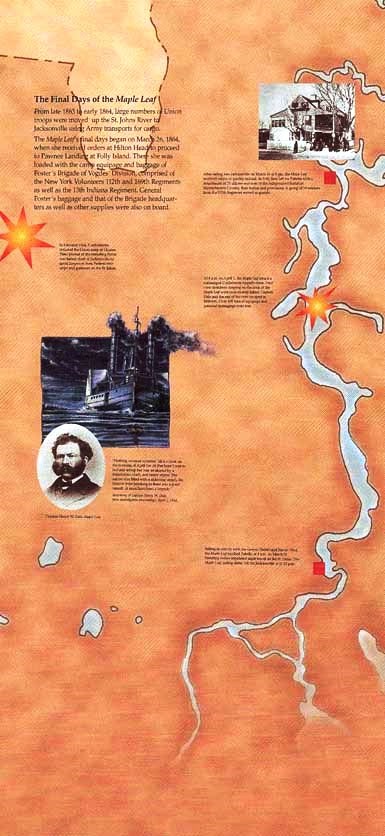Last updated: September 27, 2017
Article
Maple Leaf (Shipwreck Site)

Photo from www.mapleleafshipwreck.com, courtesy of Dr. Keith Holland
Constructed in Kingston, Ontario, the Great Lakes passenger steamship Maple Leaf set out to sea on June 18, 1851. Its first owner, Donald Bethune and Company, used the Maple Leaf as a passenger ship until the company started to flounder. Mr. Bethune subsequently fled the country and the remaining partners sold the vessel to a company based in Rochester, New York, in 1855. At the time, a new reciprocity treaty between the United States and Canada temporarily revitalized Lake Ontario shipping but by the end of the decade the United States found itself in a depression. Although the shipping trade went into decline, the charter market for steamers rose as a result of the Civil War. In 1862 the Maple Leaf was sold to Bostonians J.H.B. Lang and Charles Spear who chartered it to the U.S. Army.
The Maple Leaf was used as a transport vessel, bringing Union troops south to Virginia. In 1863, Confederate prisoners-of-war (POWs) on the ship overpowered their guards and took control of the vessel. After landing, the POWs escaped to Richmond. The Union recovered the boat and continued to use it to transport troops along the East Coast until 1864. In April of that year, the Maple Leaf struck a Confederate "torpedo" (what we would now call a mine) off Mandarin Point in the St. John's River. The explosion tore the bow of the ship apart, ripping through the deck and killing four soldiers. The vessel sank quickly, but apart from those lost in the explosion there were no other fatalities.
The Maple Leaf was never salvaged and, while the U.S. Treasury Department attempted to sell the wreck and signed two contracts in 1873 and 1876 that required removal of the wreck, no sale occurred. Since the remains of the Maple Leaf were blocking a portion of the river and were a serious threat to other vessels, in 1882 the U.S. Army Corps of Engineers contracted to move the wreck to its present location. The Maple Leaf is 181 feet long by 25 feet wide and weighs 398 tons. The wreck is buried beneath 7 feet of mud in 20 feet of water. It is extremely well preserved under the mud with the hull virtually intact save for the starboard box and deck, which were damaged in the explosion. However, what makes the wreck of the Maple Leaf truly amazing is the vast amount of cargo associated with the submerged steamer. More than 3,000 individual artifacts have been recovered from the Maple Leaf and are on public display at the Jacksonville Museum of Science and History.
The Maple Leaf wreck, a National Historic Landmark, lies in the middle of the St. John's River about 12 miles south of downtown Jacksonville. Unlike other shipwrecks on this itinerary, the public is not permitted to dive on the Maple Leaf. The St. John's River is extremely muddy and the visibility in the area around the Maple Leaf is extremely poor. It is possible to view the artifacts recovered from the Maple Leaf at the Jacksonville Museum of Science and History. The exhibit contains the largest single collection of Civil War artifacts in the world, along with recovered sections of the wreck. For more information visit Maple Leaf Shipwreck.
